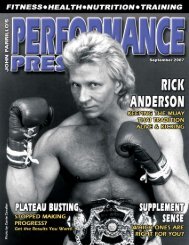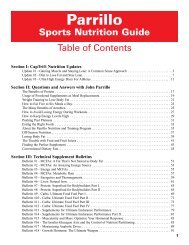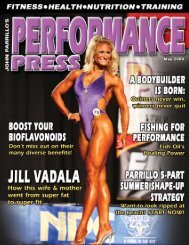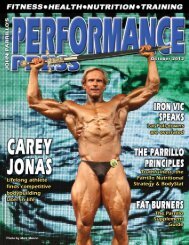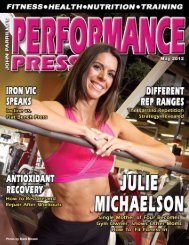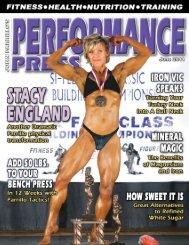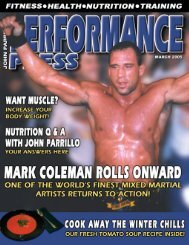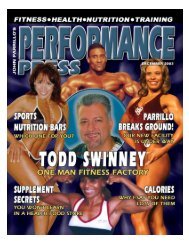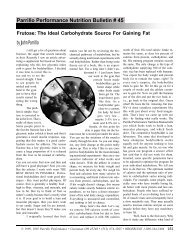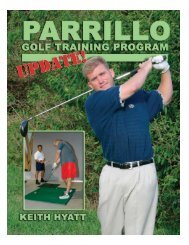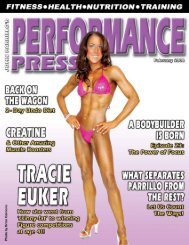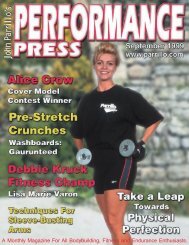John Parrillo'sJohn Parrillo's - Parrillo Performance
John Parrillo'sJohn Parrillo's - Parrillo Performance
John Parrillo'sJohn Parrillo's - Parrillo Performance
You also want an ePaper? Increase the reach of your titles
YUMPU automatically turns print PDFs into web optimized ePapers that Google loves.
Post Workout Nutrition<br />
The new <strong>Parrillo</strong> Energy Bars are a conventional way to<br />
get quality calories in after a workout.<br />
50/50 Plus Powder provides<br />
your body with the protein & carbohydrates<br />
it needs to recover<br />
from your workouts.<br />
ingesting carbohydrate alone. This<br />
translates into a far more potent anabolic<br />
stimulus, resulting in greater<br />
muscle accrual. Also, this combination<br />
is more effective at replenishing glycogen<br />
stores than carbohydrate alone (3).<br />
Since the goal is to heal and build<br />
muscle, the optimal recovery meal<br />
should contain a mixture of protein and<br />
carbohydrate.<br />
How much carb and protein per postworkout<br />
feeding is optimal? The answer<br />
is not precise - and may never be. It<br />
varies depending on your goals and<br />
bodyweight. It you want to gain size<br />
the post-workout meal should contain<br />
more calories than if you are desirous<br />
of losing bodyfat. In previous articles I<br />
have explained at length how to determine<br />
the proper number of calories to<br />
consume to effect muscle gains or fat<br />
loss. After you determine your caloric<br />
breakeven point, divide your daily allotment<br />
of calories into five or six meals,<br />
each containing approximately the same<br />
number of calories. One of these meals<br />
should be your post-workout meal.<br />
Theoretically, your post-workout<br />
meal should actually be your biggest<br />
meal of the day. Why? The<br />
body is more efficient at oxidizing<br />
food in the post-workout state. If<br />
you are seeking to add quality<br />
muscle size, I suggest calculating<br />
how many calories each meal<br />
should contain on average and<br />
make the recovery meal one-anda-half<br />
times the average meal calorie<br />
total. Conversely, if you are<br />
trying to lose weight, then the<br />
post-workout meal should contain<br />
the same caloric content as the<br />
other meals.<br />
Through scientific research and<br />
years of working with the world’s<br />
top bodybuilders, I have found<br />
that a mixture of about 50% protein and<br />
50% carbohydrates is ideal for a postworkout<br />
feeding. This is the rationale<br />
and basis for our 50-50 Plus Powder,<br />
which is the ideal post-workout recovery<br />
drink. Many people rely on supplements<br />
after working out because few are<br />
hungry for solid food immediately after<br />
exercise. Our nutrition Bars are another<br />
easy way to get quality calories in after<br />
a workout - and convenient also. They<br />
are available in several different proteincarbohydrate<br />
ratios to suit your individual<br />
needs. Timing is important: the<br />
sooner you eat after a high intensity training<br />
session the better off you will be.<br />
There exists a “window of nutritional<br />
opportunity” that opens immediately<br />
after exercise during which glycogen resynthesis<br />
rates are maximal. This window<br />
stays open for roughly two hours<br />
after the cessation of exercise (6). Considering<br />
that it takes some time for the<br />
nutrients to be digested and absorbed, I<br />
would suggest you eat your recovery<br />
meal as soon as you can after exercise,<br />
to take advantage of the open window<br />
before it snaps shut. This is another reason<br />
why supplements are ideal as postexercise<br />
meals. They are easy to prepare<br />
and quickly absorbed. A shaker<br />
bottle with four to six scoops of 50-50<br />
Plus Powder, placed in your gym bag<br />
makes an ideal post workout recovery<br />
drink. In edition to the 50/50 Plus Powder<br />
it is imperative you get a meal<br />
within 2 hours of completion of your<br />
workout. Next month we can talk in<br />
more detail about carbohydrate metabolism<br />
during exercise and go into carbohydrate<br />
and fluid repletion during exercise.<br />
References<br />
1. Chandler RM, Byrne HK, Patterson<br />
JG, and Ivy JL. Dietary supplements affect<br />
the anabolic hormones after weight<br />
training exercise. J. Appl. Physiol. 76(2):<br />
839-845, 1994.<br />
2. Rabinowitz D, Merimee TJ, Maffezzoli<br />
R, and Burgess JA. Patterns of hormonal<br />
release after glucose, protein, and glucose<br />
plus protein. Lancet 2: 454-457,<br />
1966.<br />
3. Zawadzki KM, Yaspelkis BB, and Ivy<br />
JL. Carbohydrate-protein complex increases<br />
the rate of muscle glycogen<br />
storage after exercise. J. Appl. Physiol.<br />
72: 1854-1859, 1992.<br />
4. Nicholas CW, Green PA, Hawkins<br />
RD, and Williams C. Carbohydrate intake<br />
and recovery of intermittent running<br />
capacity. Int. J. Sports Nutr. 7: 251-<br />
260, 1997.<br />
5. Pizza FX, Flynn MG, Duscha BD,<br />
Holden J, and Kubitz ER. A carbohydrate<br />
loading regimen improves high<br />
intensity, short duration exercise performance.<br />
Int. J. Sports Nutr. 5: 110-116, 1995.<br />
6. Liebman M and Wilkinson JG. Carbohydrate<br />
metabolism and exercise. Chapter<br />
2 in Nutrition in Sport and Exercise,<br />
Wolinsky and Hickson, editors. CRC<br />
Press, Boca Raton, 1994.<br />
Info-Line: 513•531•1311 <strong>John</strong> <strong>Parrillo</strong>’s <strong>Performance</strong> Press • May 1999 17



